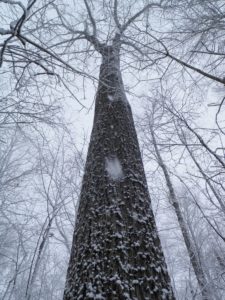Avoid a Golden-Goose Approach to Forestry
Smart woodlot stewardship makes sense — and a whole lot of dollars — for you and your family.
What do you call a livestock farmer who spends decades improving the genetics of their herd, then abruptly sells all the best animals to start a new herd from scraggly, unproven stock? Crazy, perhaps, or foolish at the very least. (Or maybe someone with a gambling debt…)
Under normal circumstances, no farmer culls their best animals to start over with random ones. Yet it’s common for a woodlot owner to sell all the large, well-formed trees during a timber sale and leave nothing but small and defective trees to regenerate the next forest.
Genetic variation in trees works just like it does in other organisms. If you take a thousand seedlings, some are going to have a slight genetic advantage. Maybe they are more efficient at photosynthesis, or they’re less apt to develop weak (narrow) branch attachments prone to breakage. When an unusually straight, fast-growing tree rises head and shoulders above its peers, it’s generally more than mere chance — that tree probably has something the others don’t, and that’s the one you want seeding the next forest.
The multigenerational process of choosing superior genetics in trees is called “silviculture.” Ideally a forester marks defective trees to cull for firewood, and marks some mature trees for harvest. She or he intentionally leaves some of the very best trees for seed.
This kind of timber production is sustainable in both an ecological and economic sense. Not only does the overall gene pool improve, but periodic selective harvesting creates openings in the forest canopy, increasing habitat diversity as it releases understory trees.
Many forest owners have heard of silviculture but continue to practice what some foresters call “silver-culture,” maximizing short-term gain at the expense of long-term forest health. Harvesting all trees above a certain size, known as a diameter-limit cut, has been called “selective harvesting” by unscrupulous loggers (and even the occasional forester).
Land owners can protect themselves from such deception by hiring a consulting forester to inventory timber, mark trees and oversee a harvest. For information on locating a consulting forester, contact your New York State Department of Environmental Conservation office.
The thing is, a diameter-limit cut may be worse than clear cutting. Like a clear-cut, it causes much residual damage and soil disturbance. Coupled with greatly increased light penetration, this can lead to unwanted vegetation taking hold, either an invasive like swallow-wort or a native like hay-scented fern. Such plants are called “interfering vegetation” because they inhibit seedling germination and survival, often delaying the start of forest regeneration for many years.
Nearly all forests are roughly even-aged, meaning tree size differences have more to do with genetics than with age. While clear-cuts take the bad with the good, diameter-limit cuts take only the best, leaving the runts to re-seed the forest. Going back to the livestock producer, this is like a farmer knowingly getting a sire whose offspring produce less milk, not more.
A prevailing opinion in our culture right now seems to be that doing the right thing for the environment will hurt financially. Although that may seem true in some instances, it is definitely not the case in forestry.
Dr. Ralph Nyland, Professor of Forestry at the State University of New York College of Environmental Science and Forestry in Syracuse, stresses that forestry is a very long-term endeavor. He believes we have to start thinking much farther into the future. Dr. Nyland illustrates why good forestry make the most sense — and dollars — in the following example:
Assume you and your neighbor have identical woodlots with salable timber (everything 16” in diameter and larger) worth $20,000. Your neighbor goes for a diameter-limit cut and gets that entire amount. But you mark a select cut, harvesting $10,000 worth of timber and leaving trees of equivalent value standing. It sounds like your neighbor made out better, doesn’t it? Just wait.
The next time you can harvest is fifteen years later. By that time, your timber is worth $34,000. You harvest half, leaving trees valued at $17,000. Your neighbor won’t yet have enough salable timber for a harvest at this time.
Thirty years after the first cut, your neighbor again has salable timber valued at $20,000. Their total income plus residual value after 30 years is $40,000. Your timber, though, will now be worth $77,000, which means that your total income plus residual value after 30 years is $104,000. Now we have two winners, both you and your woodlot.
OK, what do you call a poultry farmer who kills the goose that lays one golden egg each day just to get his hands on two or three gilded ova all at once? Well, for starters you’d call them fictional, but also dumb as a rock. Don’t manage your woodlot like that.
Silviculture will give you a healthy woodlot and a healthy bank account. “Silver-culture” will give you bad metaphors, a lower income, and a lot of poor-quality trees to pass onto the next generation.
Resource Spotlight: http://cornellforestconnect.ning.com/


